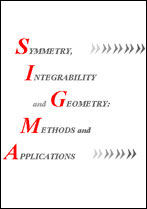|
gl(3) Polynomial Integrable System: Different Faces of the 3-Body/A2 Elliptic Calogero Model
Alexander V. Turbiner, Juan Carlos Lopez Vieyra, Miguel A. Guadarrama-Ayala
Instituto de Ciencias Nucleares, Universidad Nacional Autónoma de México, Apartado Postal 70-543, 04510 Ciudad de México, Mexico
Abstract:
It is shown that the gl(3) polynomial integrable system, introduced by Sokolov–Turbiner in [ J. Phys. A 48 (2015), 155201, 15 pages, arXiv: 1409.7439], is equivalent to the gl(3) quantum Euler–Arnold top in a constant magnetic field. Their Hamiltonian as well as their third-order integral can be rewritten in terms of gl(3) algebra generators. In turn, all these gl(3) generators can be represented by the non-linear elements of the universal enveloping algebra of the 5-dimensional Heisenberg algebra h5(ˆp1,2,ˆq1,2,I), thus, the Hamiltonian and integral are two elements of the universal enveloping algebra Uh5. In this paper, four different representations of the h5 Heisenberg algebra are used: (I) by differential operators in two real (complex) variables, (II) by finite-difference operators on uniform or exponential lattices. We discovered the existence of two 2-parametric bilinear and trilinear elements (denoted H and I, respectively) of the universal enveloping algebra U(gl(3)) such that their Lie bracket (commutator) can be written as a linear superposition of nine so-called artifacts – the special bilinear elements of U(gl(3)), which vanish once the representation of the gl(3)-algebra generators is written in terms of the h5(ˆp1,2,ˆq1,2,I)-algebra generators. In this representation all nine artifacts vanish, two of the above-mentioned elements of U(gl(3)) (called the Hamiltonian H and the integral I) commute(!); in particular, they become the Hamiltonian and the integral of the 3-body elliptic Calogero model, if (ˆp,ˆq) are written in the standard coordinate-momentum representation. If (ˆp,ˆq) are represented by finite-difference/discrete operators on uniform or exponential lattice, the Hamiltonian and the integral of the 3-body elliptic Calogero model become the isospectral, finite-difference operators on uniform-uniform or exponential-exponential lattices (or mixed) with polynomial coefficients. If (ˆp,ˆq) are written in complex (z,ˉz) variables the Hamiltonian corresponds to a complexification of the 3-body elliptic Calogero model on C2.
Keywords:
elliptic Calogero model, integrable systems, 3-body systems.
Received: July 26, 2023; in final form January 22, 2024; Published online February 3, 2024
Citation:
Alexander V. Turbiner, Juan Carlos Lopez Vieyra, Miguel A. Guadarrama-Ayala, “gl(3) Polynomial Integrable System: Different Faces of the 3-Body/A2 Elliptic Calogero Model”, SIGMA, 20 (2024), 012, 23 pp.
Linking options:
https://www.mathnet.ru/eng/sigma2014 https://www.mathnet.ru/eng/sigma/v20/p12
|

| Statistics & downloads: |
| Abstract page: | 74 | | Full-text PDF : | 25 | | References: | 17 |
|




 Contact us:
Contact us: Terms of Use
Terms of Use
 Registration to the website
Registration to the website Logotypes
Logotypes









 Citation in format
Citation in format 